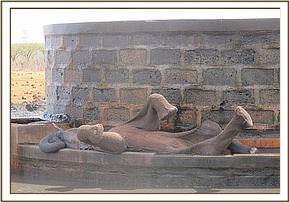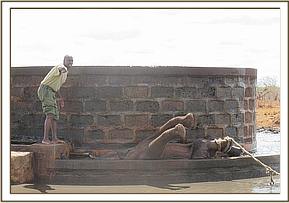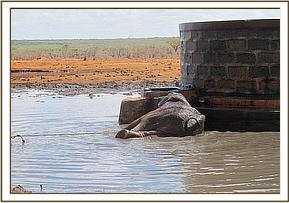Tsavo's vulnerable elephant populations are common visitors to the neighbouring Taita Ranches, which are mineral rich areas lying between the southern section of Tsavo West and north-eastern section of Tsavo East National Park
Tsavo's vulnerable elephant populations are common visitors to the neighbouring Taita Ranches, which are mineral rich areas lying between the southern section of Tsavo West and north-eastern section of Tsavo East National Park. Taita Ranch has been a migratory route for elephants for many hundreds of years, where huge herds once traversed the country long before mankind inhabited it, yet today this area is now comprised of tribal Group Ranches populated by a mixture of Kenyan tribes, many of whom were attracted to this particular region by the discovery of rubies and Tsavorite gemstones. Historically these tribal lands are the heritage of the Wataita and Wataveta people, who are predominantly agriculturalists and livestock owners, but more recently they have entered into lease agreements with Somalis. The land is viewed as good fattening grounds for Somali livestock before the cattle are walked to Mombasa's abattoirs.
The elephant's traditional corridor between what is now Tsavo West and Tsavo East is sadly now hostile terrain for most wildlife, where poaching, snaring and human-wildlife conflict is an ongoing threat, yet with this story we can see that sometimes even innocent accidents can arise from seemingly unthreatening situations.
Within this district large water tanks have been constructed to store water throughout the dry seasons. One such tank is situated in the Kivuko area of Taita Ranch for the many head of cattle, and although it is not intended to quench the thirst of the surrounding wildlife, it is an easily accessible water source for all animals, especially when it overflows.
One morning a call was received by the Tsavo East National park radio network reporting that a young elephant was trapped in the Kivuko well. As a young elephant was involved KWS immediately alerted both the DSWT Tsavo Mobile Veterinary Unit, and the Keepers of the DSWT Voi Rehabilitation Unit.
The DSWT team from the Voi Stockades was first on the scene where they found the KWS rangers waiting. The Keepers couldn't believe their eyes when they saw the muddle the young elephant, who was aged at approximately four years old, had gotten itself into.


The elephant was firmly stuck, legs and trunk waving in the air, wedged within the slim overflowing water channel surrounding the tank. How the elephant could have managed to get into such a position was anyone's guess, but a simple slip could have caused a bad fall, followed by violent struggling, which only made the elephant get even more jammed.
No one knew how long the young juvenile had been stuck in this terrible position, but the elephant seemed in good health without any injuries. The DSWT Keepers got straight to work and made a plan to pull the elephant out of the tank with the vehicle and a rope.


The rope was securely tied around the elephant's back legs and fixed to the vehicle. Maneuvering the car very carefully and slowly, the rope was put in position at an angle that caused the least strain on the elephant's legs. With careful instruction from the Keepers, who were keeping a close eye on the elephant, the vehicle began to pull the elephant out of the deep-water channel and over the wall.




At over four years of age, and already past its early milk-dependent years, this elephant was too old to be taken into the care of the DSWT, but since its fateful rescue the KWS has reported that the elephant is no longer alone and is thought to have rejoined its herd.
As always, thanks go to the Kenya Wildlife Service for their enduring work in the field and their support of our projects. If you would like to donate towards any of the DSWT's important projects please visit our website at https://www.sheldrickwildlifetrust.org/is/donate_now.asp